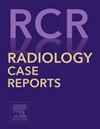眶尖综合征与颅神经V神经炎合并细菌性上颌窦炎
Q4 Medicine
引用次数: 0
摘要
上颌窦炎是一种常见的副鼻窦病理,最常见的是由细菌感染引起的。虽然通常是良性的,但当感染过程扩展到窦腔以外时,偶尔会导致严重的并发症。其中一种罕见但严重的并发症是眶尖综合征(OAS),也称为Jacod综合征,其特征是眶尖处多根脑神经功能障碍。OAS可能由多种病因引起,包括感染性、创伤性和肿瘤性原因。在感染源中,细菌性上颌窦炎是一种罕见但临床上重要的因素。累及三叉神经(颅神经V),表现为神经炎,使临床表现更加复杂。OAS的准确诊断和及时治疗在很大程度上依赖于先进的放射成像,特别是磁共振成像(MRI)。MRI在确认诊断、排除鉴别诊断、描绘鼻窦感染、眼眶炎症和神经周围受累程度(包括颅v神经炎)方面起着关键作用。这些影像学结果对指导适当的治疗策略至关重要。在这个病例报告中,我们描述了一个罕见的眼眶尖综合征与颅神经V神经炎合并细菌性上颌窦炎的病例。目的是强调MRI在诊断和治疗决策中的关键作用,并说明在此类病例中观察到的特征性放射学特征。本文章由计算机程序翻译,如有差异,请以英文原文为准。
Orbital apex syndrome associated with cranial nerve V neuritis complicating bacterial maxillary sinusitis
Maxillary sinusitis is a common pathology of the paranasal sinuses, most frequently caused by bacterial infections. Although typically benign, it can occasionally lead to severe complications when the infectious process extends beyond the sinus cavity. One such rare but serious complication is orbital apex syndrome (OAS), also known as Jacod syndrome, characterized by dysfunction of multiple cranial nerves at the orbital apex.
OAS may result from various etiologies, including infectious, traumatic, and neoplastic causes. Among infectious origins, bacterial maxillary sinusitis is an uncommon yet clinically significant contributor. Involvement of the trigeminal nerve (cranial nerve V), manifesting as neuritis, adds further complexity to the clinical presentation.
Accurate diagnosis and timely management of OAS rely heavily on advanced radiological imaging, particularly magnetic resonance imaging (MRI). MRI plays a pivotal role in confirming the diagnosis, excluding differential diagnoses, and delineating the extent of sinus infection, orbital inflammation, and perineural involvement, including neuritis of cranial nerve V. These imaging findings are essential for guiding appropriate therapeutic strategies.
In this case report, we describe a rare instance of orbital apex syndrome associated with cranial nerve V neuritis complicating bacterial maxillary sinusitis. The objective is to underscore the crucial role of MRI in both diagnosis and therapeutic decision-making, and to illustrate the characteristic radiological features observed in such cases.
求助全文
通过发布文献求助,成功后即可免费获取论文全文。
去求助
来源期刊

Radiology Case Reports
Medicine-Radiology, Nuclear Medicine and Imaging
CiteScore
1.10
自引率
0.00%
发文量
1074
审稿时长
30 days
期刊介绍:
The content of this journal is exclusively case reports that feature diagnostic imaging. Categories in which case reports can be placed include the musculoskeletal system, spine, central nervous system, head and neck, cardiovascular, chest, gastrointestinal, genitourinary, multisystem, pediatric, emergency, women''s imaging, oncologic, normal variants, medical devices, foreign bodies, interventional radiology, nuclear medicine, molecular imaging, ultrasonography, imaging artifacts, forensic, anthropological, and medical-legal. Articles must be well-documented and include a review of the appropriate literature.
 求助内容:
求助内容: 应助结果提醒方式:
应助结果提醒方式:


